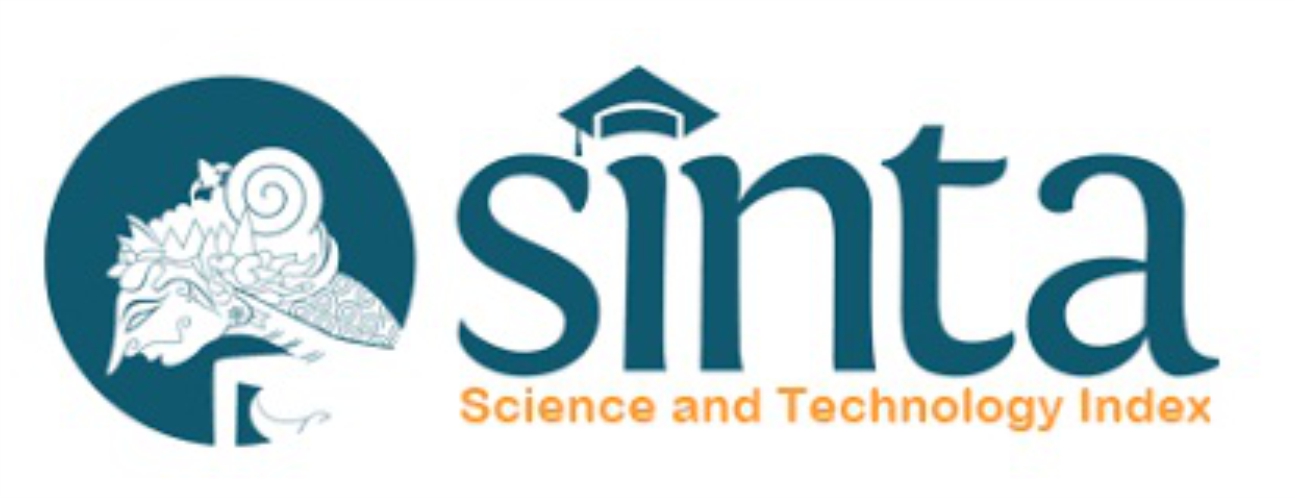Studi In Silico Senyawa Flavonoid dalam Mengambat RNA-dependent RNA polymerase (RdRp) sebagai Antivirus COVID-19
Abstract
Pada akhir tahun 2019, muncul coronavirus disease 2019 (COVID-19) yang disebabkan oleh severe acute respiratory syndrome coronavirus 2 (SARS-CoV-2), yang menjadi ancaman serius bagi kesehatan masyarakat global sampai saat ini. Seiring berjalannya waktu, pengembangan obat repurposing telah menjadi metode yang efektif. Flavonoid, sejenis senyawa, telah dikenal memiliki sifat antivirus. Oleh karena itu, tujuan dari penelitian ini adalah untuk mengidentifikasi lima senyawa flavonoid (Genistein, Daidzein, Glycitein, Formonoetin, dan Biochanin A) yang sudah dikenal memiliki berbagai manfaat farmakologi dalam menghambat aktivitas RdRp SARS-CoV-2. Untuk melakukan analisis, metode molecular docking digunakan dengan menggunakan software AutoDockTools 1.5.6. Prediksi sifat farmakokinetik dan farmakodinamik dilakukan dengan menggunakan SwissADME, sedangkan untuk mengevaluasi toksisitas, digunakan ProTox II. Hasil molecular docking menunjukkan bahwa kelima senyawa flavonoid memiliki hasil yang lebih baik dibandingkan dengan senyawa kontrol positif remdesivir. Selain itu, hasil prediksi sifat farmakokinetik, farmakodinamik, dan toksisitas menunjukkan bahwa Biochanin A, Glycitein, Genistein, dan Formonoetin memiliki potensi terbaik untuk dikembangkan sebagai obat antivirus COVID-19 dengan kemampuan mengikat reseptor RdRp dengan PDB id. 6M71.
Keywords
Full Text:
PDF (Bahasa Indonesia)References
Hu B, Guo H, Zhou P, Shi ZL. Characteristics of SARS-CoV-2 and COVID-19. Nat Rev Microbiol. 2021; 19: 141–154. https://doi.org/10.1038/s41579-020-00459-7
Wu JT, Leung K, Leung GM. Nowcasting and forecasting the potential domestic and international spread of the 2019-nCoV outbreak originating in Wuhan, China: a modelling study. The Lancet. 2020; 395(10225): 689-697.
Hui DS, Azhar EI, Madani TA, Ntoumi F, Kock R, Dar O, ..., Petersen E. The continuing 2019-nCoV epidemic threat of novel coronaviruses to global health—The latest 2019 novel coronavirus outbreak in Wuhan, China. International journal of infectious diseases. 2020; 91: 264-266.
Deng SQ, & Peng HJ. Characteristics of and public health responses to the coronavirus disease 2019 outbreak in China. Journal of clinical medicine. 2020; 9(2): 575.
Han Q, Lin Q, Jin S, You L. Coronavirus 2019-nCoV: A brief perspective from the front line. Journal of Infection. 2020; 80(4): 373-377.
Polatoğlu I, Oncu‐Oner T, Dalman I, Ozdogan S. COVID‐19 in early 2023: Structure, replication mechanism, variants of SARS‐CoV‐2, diagnostic tests, and vaccine & drug development studies. MedComm. 2023; 4(2): e228.
WHO. 2023. WHO Coronavirus (COVID-19). https://covid19.who.int/
WHO, “coronavirus (COVID-19) dashboard,” 2022, https://covid19.who.int.
Senanayake SL. Drug repurposing strategies for COVID-19. Future Drug Discovery. 2020; 2(2).
Anwaar MU, Adnan F, Abro A, Khan RA, Rehman A. U, Osama M, ..., Assir MZ. Combined deep learning and molecular docking simulations approach identifies potentially effective FDA approved drugs for repurposing against SARS-CoV-2. Computers in Biology and Medicine. 2022; 141: 105049.
Huang Y, Yang C, Xu XF, Xu W, Liu SW. Structural and functional properties of SARS-CoV-2 spike protein: potential antivirus drug development for COVID-19. Acta Pharmacologica Sinica. 2020; 41(9): 1141-1149.
Marahatha R, Shrestha A, Sharma K, Regmi BP, Sharma KR, Poudel P, ..., Parajuli N. In silico study of alkaloids: Neferine and berbamine potentially inhibit the SARS-CoV-2 RNA-dependent RNA polymerase. Journal of Chemistry. 2022.
Khare P, Sahu U, Pandey SC, Samant M. Current approaches for target-specific drug discovery using natural compounds against SARS-CoV-2 infection. Virus research. 2020; 290: 198169.
van de Leemput J, & Han Z. Understanding individual SARS-CoV-2 proteins for targeted drug development against COVID-19. Molecular and cellular biology. 2021; 41(9): e00185-21.
Koulgi S, Jani V, Uppuladinne VNM, Sonavane U, Joshi R. Natural plant products as potential inhibitors of RNA dependent RNA polymerase of Severe Acute Respiratory Syndrome Coronavirus-2. PLoS One. 2021; 16(5): e0251801.
Aftab SO, Ghouri MZ, Masood MU, Haider Z, Khan Z, Ahmad A, Munawar N. Analysis of SARS-CoV-2 RNA-dependent RNA polymerase as a potential therapeutic drug target using a computational approach. Journal of translational medicine. 2020; 18(1): 1-15.
Ganjhu RK, Mudgal PP, Maity H, Dowarha D, Devadiga S, Nag S, Arunkumar G. Herbal plants and plant preparations as remedial approach for viral diseases. Virusdisease. 2015; 26: 225-236.
Ninfali P, Antonelli A, Magnani M, Scarpa ES. Antiviral properties of flavonoids and delivery strategies. Nutrients. 2020; 12(9): 2534.
Purwitasari N, Maulana S, Qurnianingsih E, Agil M, Siswandono S, Junlatat J. Inhibition of Spike Protein of SARS-CoV2 from (Merremia mammosa (Lour) Hall. F.) Bioactive Compounds: Molecular Docking and ADMET Study. Journal of Population Therapeutics and Clinical Pharmacology. 2023; 30(8): 78-86.
Ma'arif B, Suryanto S, Muslikh FA, Suryadinata A, & Fauziyah B. Systematic Review: Anti-Osteoporosis Potential Activities of Phytoestrogen Compounds In Chrysophyllum cainito L., Elaeis guineensis Jacq., Lannea acida Rich., Marsilea crenata Presl., and Medicago sativa L. Journal of Pharmaceutical Sciences and Community. 2022; 19(1): 41-52.
Muslikh FA, Samudra RR, Ma’arif B, Ulhaq ZS, Hardjono S, & Agil M. In Silico Molecular Docking and ADMET Analysis for Drug Development of Phytoestrogens Compound with Its Evaluation of Neurodegenerative Diseases. Borneo Journal of Pharmacy. 2022; 5(4): 357-366.
Muslikh FA, Pratama RR, Gondokesumo ME. Senyawa Fitoestrogen Untuk Potensi Terapi Penyakit Neurodegeneratif Terhadap Reseptor TLR2: Pendekatan In Silico. Jurnal Kesehatan Islam. 2023; 12(1): 17-24.
Jiang Y, Yin W, Xu HE. RNA-dependent RNA polymerase: Structure, mechanism, and drug discovery for COVID-19. Biochemical and biophysical research communications. 2021; 538: 47-53.
Kokic G, Hillen HS, Tegunov D, Dienemann C, Seitz F, Schmitzova J, ..., Cramer P. Mechanism of SARS-CoV-2 polymerase stalling by remdesivir. Nature communications. 2021; 12(1): 279.
Ahsana D, Pratama RR, Meily A, Andika A. Discovery of SARS-CoV-2 RNA-dependent-RNA-polymerase (RdRp) Inhibitor from Sambiloto (Andrographis paniculata) Based on Molecular Docking and ADMET Prediction Approach. Pharmaceutical Sciences and Research. 2022; 9(2): 3.
Ma'arif B, Fihuda DAP, Muslikh FA, Syarifuddin S, Fauziyah B, Sari DP, Agil M. Studi in silico penghambatan aktivasi TLR2 ekstrak etanol daun semanggi (Marsilea crenata Presl.). Jurnal Tumbuhan Obat Indonesia. 2022; 15(1): 31-40.
Ma'arif B, Muslikh FA, Anggraini W, Taek MM, Laswati H, & Agil M. In vitro anti-neuroinflammatory effect of genistein (4', 5, 7-trihydroxyisoflavone) on microglia HMC3 cell line, and in silico evaluation of its interaction with estrogen receptor-β. International Journal of Applied Pharmaceutics. 2021; 13(4): 183-187.
Sliwoski G, Kothiwale S, Meiler J, & Lowe EW. Computational methods in drug discovery. Pharmacological reviews. 2014; 66(1): 334-395.
Muslikh FA, Samudra RR, & Ma'arif B. Prediksi Senyawa Fraksi Etil Asetat Daun Semanggi (Marsilea crenata Presl.) Sebagai Agen Antineuroinflamasi (agonis ERα). JIKSN: Jurnal Ilmu Kesehatan dan Sains Nusantara. 2023; 1(01): 10-21.
Ma'arif B, Aminullah M, Saidah NL, Muslikh FA, Rahmawati A, Indrawijaya YYA, ... & Taek MM. Prediction of antiosteoporosis activity of thirty-nine phytoestrogen compounds in estrogen receptor-dependent manner through in silico approach. Tropical Journal of Natural Product Research. 2021; 5(10): 1727-1734.
Ma'arif B, Muslikh FA, Fihuda DAP, Syarifuddin S, & Fauziyah B. Prediction of compounds from 96% Ethanol Extract of Marsilea crenata Presl. Leaves in increasing estrogen receptor-α activation. In Proceedings of International Pharmacy Ulul Albab Conference and Seminar (PLANAR). (2021, December; 1: 67-76.
Ma’arif B, Samudra RR, Muslikh FA, Dewi TJD, & Muchlasi LA. Antineuroinflammatory Properties of Compounds from Ethyl Acetate Fraction of Marsilea crenata C. Presl. Against Toll-Like Receptor 2 (3A7B) In Silico. In Proceedings of International Pharmacy Ulul Albab Conference and Seminar (PLANAR). 2022, December; 2: 8-20).
Odoemelam CS, Hunter E, Simms J, Ahmad Z, Chang MW, Percival B, ... & Wilson PB. In silico ligand docking approaches to characterise the binding of known allosteric modulators to the glucagon-like peptide 1 receptor and prediction of ADME/Tox properties. Applied Biosciences. 2022; 1(2): 143-162.
Lukitaningsih E, Wisnusaputra A, & Sudarmanto BA. Scrining in silico active compound of Pachyrrhizus erosus as antitirosinase on Aspergillus oryzae (computattional study with homology modeling and molecular docking). Majalah Obat Tradisional. 2009; 20(1): 7-15.
Az-Zahra F, Afidika J, Diamantha SD, Rahmani AE, Fatimah S, Aulifa DL, & Sitinjak BD. Studi In Silico Senyawa dalam Daun Sirih (Piper betle L.) sebagai Inhibitor Enzim Asetilkolinesterase (AChE) pada Penyakit Alzheimer. Indonesian Journal of Biological Pharmacy. 2022; 2(2): 44-58.
Rahmadi R, Andika, Nashihah S. Studi Penambatan Molekuler Senyawa Flavonoid Daun Jambu Biji (Psidium guajava L.) Terhadap Sars-Cov-2 3cl Protease. Medical Sains: Jurnal Ilmiah Kefarmasian. 2021; 6(1): 9-24.
Ma'arif B, Muslikh FA, Amalia D, Mahardiani A, Muchlasi LA, Riwanti P, ..., Agil M. Metabolite Profiling of the Environmental-Controlled Growth of Marsilea crenata Presl. and Its In Vitro and In Silico Antineuroinflammatory Properties. Borneo Journal of Pharmacy. 2022; 5(3): 209-228.
Lipinski C A, Lombardo F, Dominy BW, & Feeney PJ. Experimental and computational approaches to estimate solubility and permeability in drug discovery and development settings. Advanced drug delivery reviews. 1997; 23(1-3): 3-25.
Supandi, Yeni, Merdekawati F. In silico study of pyrazolylaminoquinazoline toxicity by lazar, protox, and admet predictor. Journal of Applied Pharmaceutical Science. 2018; 8(9): 119-129.
Campagnola G, Gong P, Peersen OB. High-throughput screening identification of poliovirus RNA-dependent RNA polymerase inhibitors. Antiviral research. 2011; 91(3): 241-251.
Wu C, Liu Y, Yang Y, Zhang P, Zhong W, Wang Y, ..., Li H. Analysis of therapeutic targets for SARS-CoV-2 and discovery of potential drugs by computational methods. Acta Pharmaceutica Sinica B. 2020; 10(5): 766-788.
Elfiky AA. SARS-CoV-2 RNA dependent RNA polymerase (RdRp) targeting: An in silico perspective. Journal of Biomolecular Structure and Dynamics. 2021; 39(9): 3204-3212.
DOI: https://doi.org/10.18860/jip.v8i1.21722
Refbacks
- There are currently no refbacks.
Copyright (c) 2023 Journal of Islamic Pharmacy

This work is licensed under a Creative Commons Attribution-ShareAlike 4.0 International License.
© 2023 Journal of Islamic Pharmacy













